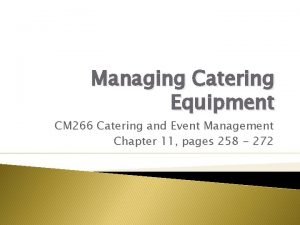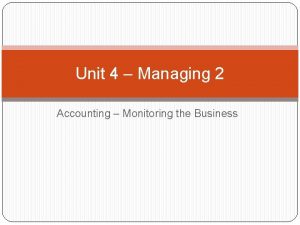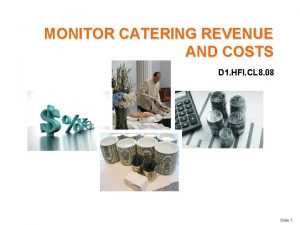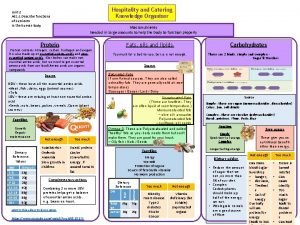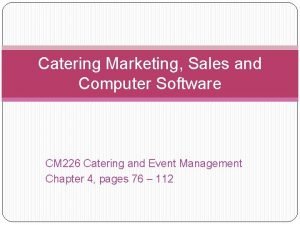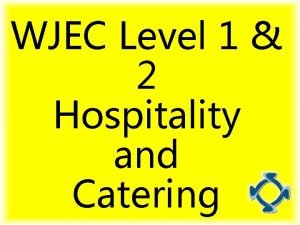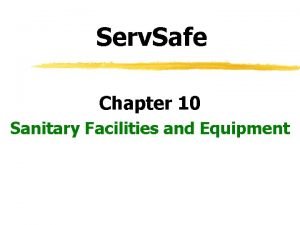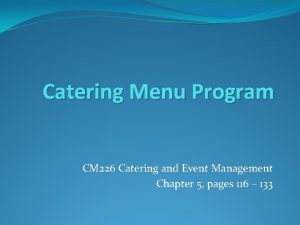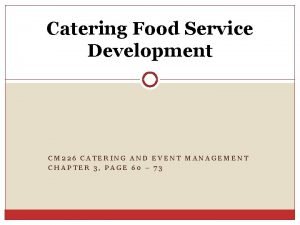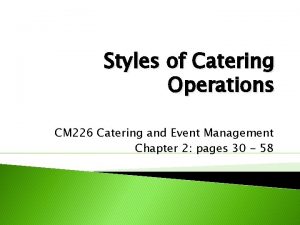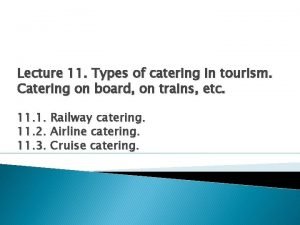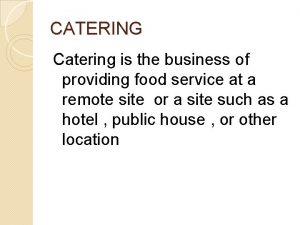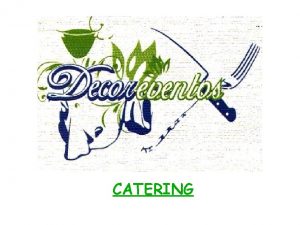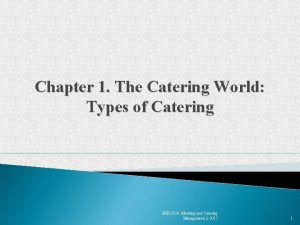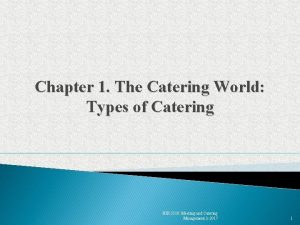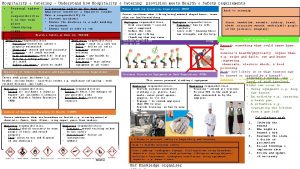Managing Catering Equipment CM 266 Catering and Event
























- Slides: 24

Managing Catering Equipment CM 266 Catering and Event Management Chapter 11, pages 258 - 272

Chapter Objectives 1. Discuss the organization of catering equipment and its role in the success of a catering operation. 2. Identify the equipment generally required for a full-service catering business. 3. Discuss special event equipment and prop inventories.

Chapter Objectives 4. Explain the role of rental companies in supplementing equipment needs.

1. MANAGING CATERING EQUIPMENT. � Catering equipment falls into two basic categories: front-of-the-house service equipment and back-of-the-house production equipment. � Management of catering equipment is the responsibility of the catering manager for service needs and the executive chef for production and kitchen needs.

2. FRONT OF THE HOUSE EQUIPMENT. � Brief overview of the categories of front-ofthe-house service equipment.

2. FRONT OF THE HOUSE EQUIPMENT. � The amount of space that needs to be allocated per guest varies with the type of function, the setting or area in which the function is being held, and the overall size of the function space. � The requirements for buffet service setup depend on the type of function, the menu, and the number of guests expected.

2. FRONT OF THE HOUSE EQUIPMENT. � Buffet setups can be incorporated into almost any type of function plan. � Chairs can range in design and function. The quality and overall design of the chairs are selected based on usage and storage requirements.

2. FRONT OF THE HOUSE EQUIPMENT. � Linens include tablecloths, napkins, placemats, and lace overlays. � Table skirting is used primarily for buffet tables and head tables for both formal and informal functions. � For special functions and themed events, chair covers are a popular way to incorporate the chair into the overall design.

3. HEART OF THE HOUSE EQUIPMENT. � The equipment for the central kitchen for any foodservice operation depends largely on basic food production needs for menu items.

3. HEART OF THE HOUSE EQUIPMENT. � The requirements of foodservice operations are based on how and where food products are: �Received �Stored �Refrigerated �Pre-prepared �Prepared �Served �Cleaned up �Disposed of

3. HEART OF THE HOUSE EQUIPMENT. � Added to these major considerations are the requirements for food sanitation and safety. � Discuss � Explain the basic kitchen setup the average production kitchen equipment

3. HEART OF THE HOUSE EQUIPMENT. � Adequate refrigeration for both raw food product and prepared foods is essential for all foodservice operations. � Small catering companies and independent catering halls may find refrigeration capacity a reoccurring problem. � For these situations refrigerator trucks and portable refrigeration units can be rented.

3. HEART OF THE HOUSE EQUIPMENT. � Dishwashing is a critical element of all food service operations. � Hotels and restaurants have dishwashing equipment in place to handle loads appropriate to the size and needs of their facilities. � Independent catering halls also have dishwashing machines in place.

3. HEART OF THE HOUSE EQUIPMENT. � Small catering companies and caterers that handle outside catering functions face an additional challenge. � Dishwashing is a critical area for food sanitation and safety. � All dishes must be scraped, sorted, and stacked to minimize breakage on the return trip to a foodservice facility.

3. HEART OF THE HOUSE EQUIPMENT. � Waste removal is another critical area of food sanitation. � Hotels, restaurants, and catering halls are equipped with combinations of compactors, garbage disposals, and/or pulpers. � Off-site catering requires that all waste, both organic and inorganic, be handled efficiently.

3. HEART OF THE HOUSE EQUIPMENT. � Waste that is returning to central production facilities must be in covered containers in which it can be transported. � Waste removal for off- premise catering should be determined and planned for prior to the function.

3. HEART OF THE HOUSE EQUIPMENT. � Ice is a requirement for both beverage and food service. � Ice machines are sized according to the need of a foodservice operation for ice on demand during a 24 - hour period. � Ice machines include three major components: production, storage, and dispensing.

3. HEART OF THE HOUSE EQUIPMENT. � Small catering companies can arrange with local ice companies to provide ice in large quantities for functions instead of investing in ice-making equipment.

4. RENTAL EQUIPMENT. �A catering operation, whether independent or associated with a restaurant, hotel, or convention center, is often requested to produce themed events, large functions, off -premise, and special events that require equipment in addition to that on hand. � In order to assure the availability of equipment, it is important to establish a relationship with at least one rental company.

4. RENTAL EQUIPMENT. � Each rental contract should be reviewed carefully for policies regarding: �Delivery and pickup �Set-up and tear-down charges �Order charges �Damage clauses �Cleaning requirements Pricing �Reservation procedures

Key Points 1. Managing catering equipment requires knowledge of both service and production techniques and procedures. 2. Back-of-the-house equipment requires constant maintenance and inspection for both operating needs and employee safety. 3. Both front-of-the-house and back-of-thehouse equipment represents a sizable portion of the overall investment in any foodservice business.

Key Points 4. 5. Managing supply and maintenance can be a time-consuming operational detail, but it should not be overlooked in a busy catering operation. Augmenting equipment inventories by using rental companies can be an effective management technique.

Key Points 6. By establishing relationships with local rental companies and planning for rental needs, catering businesses can respond to customer requests for a wide variety of functions.

 Tools of catering management
Tools of catering management Flex zel
Flex zel Assignment chem 266
Assignment chem 266 37.62 rounded to the nearest hundredth
37.62 rounded to the nearest hundredth Round 673 422 to the nearest hundred
Round 673 422 to the nearest hundred E 266
E 266 Compound probability examples
Compound probability examples Unit 4 managing an event
Unit 4 managing an event Sentinel event list
Sentinel event list Independent or dependent
Independent or dependent Independent vs dependent events
Independent vs dependent events Event management swot analysis
Event management swot analysis Bridge breaks in central java
Bridge breaks in central java Language features of news item text
Language features of news item text Wjec hospitality and catering unit 2 examples
Wjec hospitality and catering unit 2 examples Wjec hospitality and catering
Wjec hospitality and catering Food and beverage catering
Food and beverage catering Profit and loss statement
Profit and loss statement Wjec hospitality and catering knowledge organisers
Wjec hospitality and catering knowledge organisers Explain how dishes on a menu address environmental issues
Explain how dishes on a menu address environmental issues Hospitality and catering revision
Hospitality and catering revision Computer software marketing
Computer software marketing Wjec hospitality and catering unit 2 examples
Wjec hospitality and catering unit 2 examples Pp&e
Pp&e Sanitary facilities and equipment
Sanitary facilities and equipment
